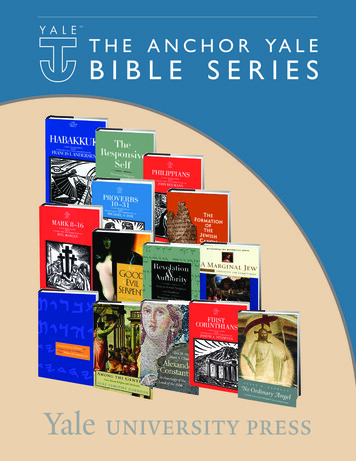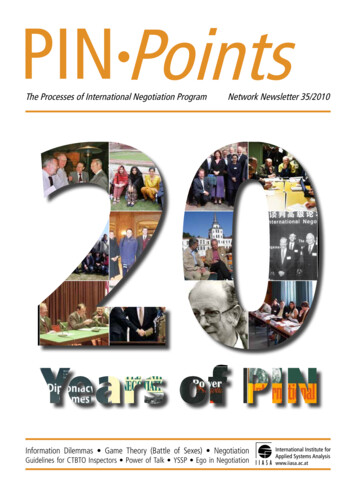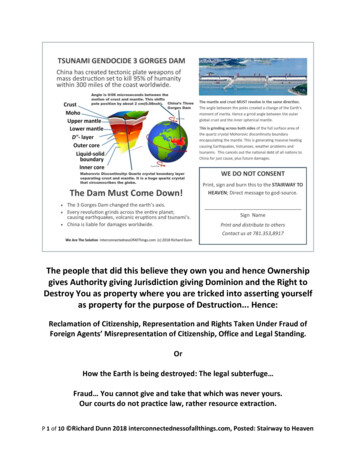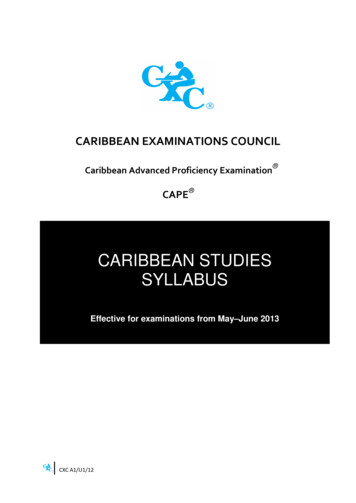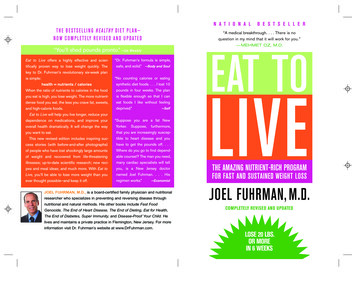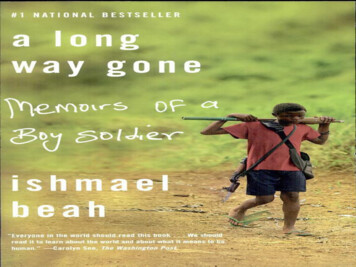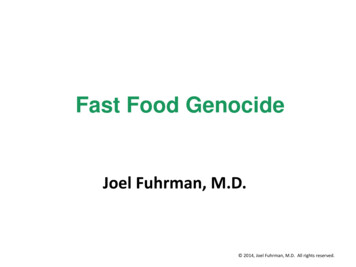
Transcription
GENOCIDEGenocide: A Comprehensive Introduction is the most wide-ranging textbook on genocide yet published. The book is designed as a text for upper-undergraduate andgraduate students, as well as a primer for non-specialists and general readers interestedin learning about one of humanity’s enduring blights.Over the course of sixteen chapters, genocide scholar Adam Jones: Provides an introduction to genocide as both a historical phenomenon and ananalytical-legal concept.Discusses the role of imperalism, war, and social revolution in fueling genocide.Supplies no fewer than seven full-length case studies of genocides worldwide, eachwith an accompanying box-text.Explores perspectives on genocide from the social sciences, including psychology,sociology, anthropology, political science/international relations, and genderstudies.Considers “The Future of Genocide,” with attention to historical memory andgenocide denial; initiatives for truth, justice, and redress; and strategies ofintervention and prevention.Written in clear and lively prose, liberally sprinkled with illustrations and personaltestimonies from genocide survivors, Genocide: A Comprehensive Introduction isdestined to become a core text of the new generation of genocide scholarship. Anaccompanying website (www.genocidetext.net) features a broad selection ofsupplementary materials, teaching aids, and Internet resources.Adam Jones, Ph.D. is currently Associate Research Fellow in the Genocide StudiesProgram at Yale University. His recent publications include the edited volumesGendercide and Genocide (2004) and Genocide, War Crimes and the West: History andComplicity (2004). He is co-founder and executive director of Gendercide Watch(www.gendercide.org).
GENOCIDEA Comprehensive IntroductionAdam Jones
First published 2006by Routledge2 Park Square, Milton Park, Abingdon, Oxon OX14 4RNSimultaneously published in the USA and Canadaby Routledge270 Madison Ave, New York, NY 10016Routledge is an imprint of the Taylor & Francis Group, an informa business 2006 Adam JonesThis edition published in the Taylor & Francis e-Library, 2006.“To purchase your own copy of this or any of Taylor & Francis or Routledge’scollection of thousands of eBooks please go to www.eBookstore.tandf.co.uk.”All rights reserved. No part of this book may be reprinted orreproduced or utilized in any form or by any electronic, mechanical,or other means, now known or hereafter invented, includingphotocopying and recording, or in any information storage orretrieval system, without permission in writing from the publishers.British Library Cataloguing in Publication DataA catalogue record for this book is available from the British LibraryLibrary of Congress Cataloging in Publication DataJones, Adam, 1963–Genocide : a comprehensive introduction / Adam Jones.p. cm.Includes bibliographical references and index.ISBN 0–415–35384–X (pbk. : alk. paper) – ISBN 0–415–35385–8 (hardback : alk. paper)1. Genocide. 2. Genocide–Case studies. I. Title.HV6322.7.J64 2006304.6’63–dc222005030424ISBN10: 0–415–35385–8ISBN10: 0–415–35384–XISBN10: 0–203–34744–7ISBN13: 978–0–415–35385–4 (hbk)ISBN13: 978–0–415–35384–7 (pbk)ISBN13: 978–0–203–34744–7 (ebk)
For Jo and David Jones, givers of life,and for Dr. Griselda Ramírez Reyes, saver of lives.
So let us not talk falsely now, the hour is getting late.Bob Dylan, “All Along the Watchtower”
CONTENTSList of illustrationsAbout the authorIntroductionPART 1 OVERVIEW1 The Origins of GenocideGenocide in prehistory, antiquity, and early modernityThe Vendée uprisingZulu genocideNaming genocide: Raphael LemkinDefining genocide: The UN ConventionBounding genocide: Comparative genocide studiesDiscussionPersonal observationsContested casesAtlantic slaveryArea bombing and nuclear warfareUN sanctions against Iraq9/11Structural and institutional violenceIs genocide ever justified?Suggestions for further 1322 Imperialism, War, and Social Revolution39Imperialism and colonialismColonial and imperial genocidesImperial faminesThe Congo “rubber terror”The Japanese in East and Southeast AsiaThe US in Indochina394041424446vii
CONTENTSThe Soviets in AfghanistanA note on genocide and imperial dissolutionGenocide and warThe First World War and the dawn of industrial deathThe Second World War and the “barbarization of warfare”Genocide and social revolutionThe nuclear revolution and “omnicide”Suggestions for further studyNotesPART 2 CASES3 Genocides of Indigenous PeoplesIntroductionColonialism and the discourse of extinctionThe conquest of the AmericasSpanish AmericaThe United States and CanadaOther genocidal strategiesA contemporary case: The Maya of GuatemalaAustralia’s Aborigines and the Namibian HereroGenocide in AustraliaThe Herero genocideDenying genocide, celebrating genocideComplexities and caveatsIndigenous revivalSuggestions for further studyNotes4 The Armenian GenocideIntroductionOrigins of the genocideWar, massacre, and deportationThe course of the Armenian genocideThe aftermathThe denialSuggestions for further studyNotes5 Stalin’s TerrorThe Bolsheviks seize powerCollectivization and famineThe 08183858789101101102105106112113115116124125127128
CONTENTSThe Great Purge of 1937–38The war yearsThe destruction of national minoritiesStalin and genocideSuggestions for further studyNotes6 The Jewish HolocaustIntroductionOrigins“Ordinary Germans” and the NazisThe turn to mass murderDebating the HolocaustIntentionalists vs. functionalistsJewish resistanceThe Allies and the churches: Could the Jews have been saved?Willing executioners?Israel and the Jewish HolocaustIs the Jewish Holocaust “uniquely unique”?Suggestions for further studyNotes7 Cambodia and the Khmer RougeOrigins of the Khmer RougeWar and revolution, 1970–75A genocidal ideologyA policy of “urbicide”, 1975“Base people” vs. “new people”Cambodia’s holocaust, 1975–79Genocide against Buddhists and ethnic minoritiesAftermath: Politics and the quest for justiceSuggestions for further studyNotes8 Bosnia and KosovoOrigins and onsetGendercide and genocide in BosniaThe international dimensionKosovo, 1998–99AftermathsSuggestions for further 202212212216219220222224224ix
CONTENTS9 Holocaust in RwandaIntroduction: Horror and shameBackground to genocideGenocidal frenzyAftermathSuggestions for further studyNotesPART 3 SOCIAL SCIENCE PERSPECTIVES10 Psychological PerspectivesNarcissism, greed, and fearNarcissismGreedFearGenocide and humiliationThe psychology of perpetratorsThe Zimbardo experimentsThe psychology of rescuersSuggestions for further 6827027427528128211 The Sociology and Anthropology of Genocide288IntroductionSociological perspectivesThe sociology of modernityEthnicity and ethnic conflictEthnic conflict and violence “specialists”“Middleman minorities”Anthropological perspectivesSuggestions for further studyNotes28828928929129329429630130212 Political Science and International Relations307Empirical investigationsThe changing face of warDemocracy, war, and genocide/democideNorms and prohibition regimesSuggestions for further studyNotesx307311314316320321
CONTENTS13 Gendering GenocideGendercide vs. root-and-branch genocideWomen and genocideGendercidal institutionsGenocide and violence against homosexualsAre men more genocidal than women?A note on gendered propagandaSuggestions for further studyNotesPART 4 THE FUTURE OF GENOCIDE14 Memory, Forgetting, and DenialThe struggle over historical memoryGermany and “the search for a usable past”The politics of forgettingGenocide denial: Motives and strategiesDenial and free speechSuggestions for further studyNotes15 Justice, Truth, and RedressLeipzig, Constantinople, Nuremberg, TokyoThe international criminal tribunals: Yugoslavia and RwandaJurisdictional issuesThe concept of a victim groupGender and genocideNational trialsThe “mixed tribunals”: Cambodia and Sierra LeoneAnother kind of justice: Rwanda’s gacaca experimentThe Pinochet caseThe International Criminal Court (ICC)International citizens’ tribunalsTruth and reconciliationThe challenge of redressSuggestions for further studyNotes16 Strategies of Intervention and PreventionWarning signsHumanitarian 75377379381382388389392xi
CONTENTSxiiSanctionsThe United NationsWhen is military intervention justified?A standing “peace army”?Ideologies and individualsThe role of the honest witnessIdeologies, religious and secularConclusionSuggestions for further studyNotes393394395396398398400404404405Index410
.115.2Raphael LemkinImperial genocide: Belgian King Leopold and the CongoBritish soldiers go “over the top” at the Battle of the Somme, 1916Atomic bomb explosion at Nagasaki, 1945The Cerro Rico silver-mines in Potosí, BoliviaLoading Indian corpses from the Wounded Knee massacre, 1890Mural of indigenous revival in Yucatán, MexicoArmenian men being deported from Harput for mass killing, May 1915Armenian refugees, 1915A supporter of Stalin and Lenin carries their portraits in Red SquareRuins of a gas chamber and crematorium complex at Auschwitz-BirkenauMass burial of corpses at Bergen-Belsen concentration camp, 1945A Soviet prisoner-of-war is dispatched “to the rear”Photos of Cambodians incarcerated and killed at Tuol Sleng prison, Phnom PenhMass grave at Pilice, near SrebrenicaTutsi women murdered in the Rwandan genocide of 1994Core structure of the Milgram experimentsPer Anger with a portrait of Raoul WallenbergPass issued to Lili Katz by the Swedish legation in Budapest, 1944Forensic anthropologist Clyde SnowPolitical scientist R.J. RummelDemobilized child soldiers in the Democratic Republic of Congo, 2002Nazi propaganda poster vilifying Jewish menTutsi women depicted seducing UN force commander General Roméo DallaireThe Naval Mechanics School in the Buenos Aires suburb of PalermoJudgment at Nuremberg, 1946Luis Moreno Ocampo, the first prosecutor of the International Criminal Court 77277300308312335335347365374 MAPSWorld map5a.1 Chechnya7.1 Cambodiaxvi–xvii142187xiii
ILLUSTRATIONS7a.18.18a.19.19a.19a.2East 251253 e: scholarly definitionsTibet under Chinese ruleOne woman’s story: VergeenThe Anfal Campaign against Iraqi Kurds, 1988One man’s story: Janusz BardachChechnyaOne woman’s story: Nechama EpsteinThe Nazis’ other victimsOne girl’s story: Loung UngEast TimorOne man’s story: Nezad AvdicGenocide in Bangladesh, 1971One woman’s story: Gloriose MukakanimbaCongo and Darfur1594109119131141155168196206218227240250
ABOUT THE AUTHORAdam Jones was born in Singapore in 1963, and grew up in England and Canada. He is currentlyAssociate Research Fellow in the Genocide Studies Program at Yale University. He holds an MA fromMcGill University and a Ph.D. from the University of British Columbia, both in political science. Hehas edited two volumes on genocide: Gendercide and Genocide (Vanderbilt University Press, 2004) andGenocide, War Crimes and the West: History and Complicity (Zed Books, 2004). He has also publishedtwo books on the media and political transition. His scholarly articles have appeared in Review ofInternational Studies, Ethnic and Racial Studies, Journal of Genocide Research, Journal of Human Rights,and other publications. He is co-founder and executive director of Gendercide Watch (www.gendercide.org), a Web-based educational initiative that confronts gender-selective atrocities worldwide. Jones haslived and traveled in over sixty countries on every populated continent. His freelance journalism andtravel photography, along with a selection of scholarly writings, are available at http://adamjones.freeservers.com. Email: adam@genocidetext.net.xv
Germany(Chs. 1, 2, 3, 6, 10, 11, 13,14, 15, 16, Box text 6a)Canada(Ch. 3)France(Ch. 1)United States(Chs. 1, 2, 3, 12)Haiti(Ch. 1)DominicanRepublic(Ch. 3)Mexico (Ch. 3)Guatemala(Ch. 3)Sierra Leone(Ch. 15)BrazilPeru(Ch. 1)(Ch. 3)Bolivia(Ch. 3)Chile(Ch. 15)Argentina(Ch. 14)World Map Cases of genocide and mass conflict referenced in this bookSource: Chartwell Illustrators
Poland(Ch. 6, Box text 6a)Russia/former Soviet Union(Chs. 2, 5, 16, Box texts 5a, 6a)Kurdish regionof IraqUkraine(Ch. 5, Box text 6a)(Box text 5a)Chechnya(Box text 5a)2Kazakhstan1(Ch. 5)Afghanistan4(Ch. 2)ChinaJapan(Chs. 2, 3, Box text 3a)3(Chs. 1, 2, 13, 15)Tibet(Box text 3a)Turkey(Chs. 4, 10,11, 14, 15)IraqIndia(Ch. 1, Boxtext 4a)(Chs. 2, 13)PakistanBangladeshDarfurVietnam(Ch. 2)(Box text 8a)Cambodia(Chs. 7, 15)(Box text 8a)(Box text 9a)East Timor(Box text 7a)Rwanda(Chs. 9, 10, 11, 13, 15)Burundi(Ch. 9)Congo(Ch. 2, Box text 9a)Australia(Chs. 3, 15)Namibia(Ch. 3)1 Bosnia and Herzegovina(Chs. 8, 13, 14, 15)2 Croatia(Chs. 1, 8)3 Kosovo(Chs. 8, 16)4 Yugoslavia/Serbia(Chs. 8, 13, 14, 15)New Zealand(Ch. 15)
Introduction WHY STUDY GENOCIDE?“Why would you want to study that?”If you spend any time seriously investigating genocide, or even if you only leavethis book lying in plain view, it is likely you will have to deal with this question.Underlying it is a tone of distaste and skepticism, perhaps tinged with suspicion.There may be a hint that you are guided by a morbid fixation on the worst of humanhorrors. How will you respond? Why, indeed, study genocide?First and foremost, if you are concerned about issues such as peace, humanrights, and social justice, there is a sense that with genocide you are confronting the“Big One,” what Joseph Conrad called the “heart of darkness.” That can be deeplyintimidating and disturbing. It can even make you feel trivial and powerless. Butgenocide is the opposite of trivial. Whatever energy and commitment you invest inunderstanding genocide will be directed towards comprehending and confrontingone of humanity’s greatest scourges.Second, intellectually, to study genocide is to study our historical inheritance.It is unfortunately the case that all stages of recorded human existence, and nearlyall parts of the world, have known genocide at one time or another, often repeatedly.Furthermore, genocide may be as prevalent in the contemporary era as at any timein history. Inevitably, there is something depressing about this: Will humanity everchange? But there is also interest and personal enlightenment to be gained by delvinginto the historical record, for which genocide serves as a point of entry. I wellremember the period, half a decade ago, that I devoted to voracious reading of thegenocide studies literature, and exploring the diverse themes this opened up to me.xviii
INTRODUCTIONFor the first time, events as varied as the European witch-hunts, the War of the TripleAlliance in South America (1864–70), the independence struggle in EastPakistan/Bangladesh, the global plagues of maternal mortality and forced labor – allwere revealed to my bleary eyes. (I was researching case-studies for the GendercideWatch website (www.gendercide.org), which explains the eclectic choice of subjectmatter.) The accounts were grim – sometimes relentlessly so. But they were alsospellbinding, and they gave me a better grounding not only in world history, butalso in sociology, psychology, anthropology, and a handful of other disciplines.This raises a third reason to study genocide: it brings you into contact with someof the most interesting and exciting debates in the social sciences and humanities.To what extent should genocide be understood as reflecting epic social transformations such as modernity, the rise of the state, and globalization? How has warfarebeen transformed in recent times, and how are the “degenerate” and decentralizedwars of the present age linked to genocidal outbreaks? How does gender shapegenocidal experiences and genocidal strategies? How is history “produced,” and whatrole do memories or denial of genocide play in that production? These are only afew of the themes to be examined in this book. I hope they will lead readers, as theyhave led me, towards an engagement with cutting-edge debates that have a wider,though not necessarily deeper, significance.In writing this book, I am standing on the shoulders of giants: the genocidescholars without whose trail-blazing efforts my own work would be inconceivable.You may find their approach and humanity inspiring, as I do. One of my principalconcerns is to provide an overview of the core literature in genocide studies; thuseach chapter and box-text is accompanied by recommendations for further study.Modern academic writing, particularly in the social sciences and humanities, isoften riddled with impenetrable jargon and not a little pomposity. It would bepleasant to be able to report that genocide studies is free of such baggage. It isn’t; butit is less burdened by it than most other fields of study. It seems this has to do withthe experience of looking into the abyss, and finding that the abyss looks back. Oneis forced to ponder one’s own human frailty and vulnerability; one is even pressedto confront one’s own capacity for hating others, for marginalizing them, forsupporting their oppression and annihilation. These realizations aren’t pretty, but theyare arguably necessary. And they can lead to a certain humility – a rare quality indeedin academia. I once described to a friend why the Danish philosopher SørenKierkegaard (1813–55) moved me so deeply: “It’s like he’s grabbing you by the armand saying, ‘Look. We don’t have much time. There are important things we needto talk about.’” You sense the same reading much of the genocide-studies literature:that the issues are too vital, and time too limited, to beat around the bush. GeorgeOrwell famously described political speech – he could have been referring to someacademic writing – as “a mass of words [that] falls upon the facts like soft snow,blurring the outlines and covering up all the details.”1 By contrast, the majority ofgenocide scholars inhabit the literary equivalent of the Tropics. I hope to take upresidence there too.Finally, some good news for the reader interested in understanding and confronting genocide: your studies and actions may make a difference. To study genocideis to study processes by which hundreds of millions of people met brutal ends. Butxix
INTRODUCTIONthere are many, many people throughout history who have bravely resisted theblind rush to hatred. They are the courageous and decent souls who gave refuge tohunted Jews or desperate Tutsis. They are the religious believers of many faiths whostruggled against the tide of evil, and spread instead a message of love, tolerance, andcommonality. They are the non-governmental organizations that warned againstincipient genocides and carefully documented those they were unable to prevent.They are the leaders and common soldiers – American, British, Soviet, Vietnamese,Indian, Tanzanian, Rwandan, and others – who vanquished genocidal regimes inmodern times.2 And yes, they are the scholars and intellectuals who have honed ourunderstanding of genocide, while at the same time working outside the ivory towerto alleviate it. You will meet some of these individuals in this book. I hope their storiesand actions will inspire you to believe that a future free of genocide and other crimesagainst humanity is possible.But . . .Studying genocide, and trying to prevent it, is not to be entered into lightly.A theme that has not been systematically addressed in the genocide studies literatureis the psychological and emotional impact such studies can have on the investigator.How many genocide students, scholars, and activists suffer, as do their counterpartsin the human rights and social work fields?3 How many experience depression,insomnia, nightmares as a result of immersing themselves in the most atrocioushuman conduct?The trauma is especially intense for those who have actually witnessed genocide,or its direct consequences, up close. During the Turkish genocide against Armenians(Chapter 4), the US Ambassador to Constantinople, Henry Morgenthau, receiveda stream of American missionaries who had managed to make their way out of thekilling zone. “For hours they would sit in my office with tears streaming down theirfaces,” Morgenthau recalled; many had been “broken in health” by the atrocities theyhad witnessed.4 My friend Christian Scherrer, who works at the Hiroshima PeaceInstitute, arrived in Rwanda in November 1994 as part of a United Nationsinvestigation team, only a few months after the slaughter of a million people had beenterminated by forces of the Rwandan Patriotic Front (RPF) (see Chapter 9). Rottingbodies were still strewn across the landscape. “For weeks,” Scherrer writes,following directions given by witnesses, I carefully made my way, step by step, overfarmland and grassland. Under my feet, often only half covered with earth, laythe remains of hundreds, indeed thousands, of unfortunate individuals betrayedby their neighbors and slaughtered by specially enlisted bands of assassins . . . astate-sponsored mass murder . . . carried out with a level of mass participation bythe majority population the like of which had never been seen before. . . . Manyof those who came from outside shared the experience of hundreds of thousandsof Rwandans of continuing, for months on end, or even longer, to grieve, to weepinternally, and, night after night, to be unable to sleep longer than an hour ortwo. When they returned to Europe, many of my colleagues felt paralyzed.He describes the experience as “one of the most painful processes I have ever beenthrough,” and the writing of his fine book, Genocide and Crisis, as “part of a personalxx
INTRODUCTIONprocess of grieving.” “Investigation into genocide,” he adds, “is something thatremains with one for life.”5 Even as a latecomer to the Rwandan genocide – and assomeone who has never visited the country – I remember being so shaken by readinga massive, agonizingly detailed human rights report on the genocide6 that I dreamedabout Rwanda for many nights, feverish visions of encountering Hutu roadblocks,of smuggling desperate Tutsis to Burundi. . . .Now that interest in genocide is growing exponentially, and the field ofcomparative genocide studies along with it, this may be a good time to undertake asurvey (say, of members of the International Association of Genocide Scholars) toascertain how common such symptoms are among those who devote their lives tothe theme. Meanwhile, I encourage you – especially if you are just beginning yourexploration – to be attentive to signs of personal stress. Talk about it with your fellowstudents, your colleagues, or family and friends. Dwell on the positive examples ofbravery and love for others that the study of genocide regularly provides. If that doesn’twork, seek counseling through the resources available on your campus or in yourcommunity. WHAT THIS BOOK TRIES TO DO, AND WHYI see genocide as inseparable from the broad thrust of history, both ancientand modern – indeed, it is among history’s defining features, overlapping a range ofcentral historical processes: war, imperialism, state-building, class struggle. I perceiveit as intimately linked to key institutions, in which state or broadly politicalauthorities are often but not always principal actors: forced labor, military conscription, incarceration, female infanticide.I adopt a comparative approach that does not elevate particular genocides overothers, except to the extent that scale and intensity warrant special attention. Virtuallyall definable human groups – the ethnic, national, racial, and religious ones thatanchor the legal definition of genocide, and others besides – have been victims ofgenocide in the past,7 and are vulnerable in specific contexts today. Equally, mosthuman collectivities – even vulnerable and oppressed ones – have proved capable ofinflicting genocide. This can be a painful acknowledgment for genocide scholars tomake, and for that reason it is routinely avoided. But it will be confronted head-onthroughout this volume: there are no sacred cows here. Respect for taboos and tendersensibilities takes a back seat to the imperative to get to grips with genocide – toconfront it in as clear-eyed a way as possible; to reduce the chances that mystificationand wishful thinking will cloud recognition, and thereby blunt effective opposition.The subject of genocide has never been more prominent in the public andacademic debate than it is today. As one indication, consider the awarding of both thePulitzer Prize and the National Book Award to Samantha Power for her 2002 work,“A Problem From Hell”: America and the Age of Genocide, which criticized Westernpassivity in the face of genocide.8 Power’s book rapidly became a nucleus aroundwhich a mainstream interest in genocide could coalesce.“A Problem from Hell” was as much culmination as catalyst, however. The field ofcomparative genocide studies has been developing for almost six decades. But itxxi
INTRODUCTIONlanguished between the 1940s, when Raphael Lemkin coined the term “genocide”and the UN Convention was propounded, and the early 1980s, when Leo Kuperpublished his field-defining contribution, Genocide: Its Political Use in the TwentiethCentury (1981).9 In the late 1980s and the 1990s, the field blossomed, with theformation of the International Association of Genocide Scholars (IAGS) in 1994, andthe publication of dozens of monographs and comparative studies – thousands, ifwe include the literature focused on the Jewish catastrophe under Nazism.Despite this proliferation, comparative genocide studies arguably has yet to findits introductory textbook. Some important edited volumes have come closest toestablishing themselves as core texts (notably Frank Chalk and Kurt Jonassohn’sHistory and Sociology of Genocide, and Samuel Totten et al.’s Century of Genocide:Eyewitness Accounts and Critical Views).10 As a single-authored work, the classic inthe field probably remains Kuper’s Genocide; but it is now well over two decades old,and its author sadly deceased. Meanwhile, two fine encyclopedias and a couple ofspecialized bibliographies have been published, but these are costly and unwieldy forthe student or general reader.Excellent and accessible books on genocide have been published in recent years,though the large majority adopt a specific disciplinary perspective. A partial exceptionis probably the best of these texts, Alex Alvarez’s Governments, Citizens, and Genocide,which approaches the subject from the angle of both political science and sociology.11Various scholars have explored psychological perspectives, including Roy Baumeister,Ervin Staub, and James Waller.12 Martin Shaw has added an important volume onWar and Genocide, from an international relations and conflict studies framework.13Meanwhile, highly stimulating work has begun to emanate from the discipline ofanthropology. Nancy Scheper-Hughes and Beatriz Manz, among others, have doneimportant work on genocide and crimes against humanity. Their work has beenbolstered by two anthologies of anthropological studies edited by Alexander LabanHinton.14Last but not least, a rich body of case studies and comparative-theoretical materialhas accumulated – one this book leans on heavily, with appropriate citation. Thus itnow seems an opportune moment to offer a comprehensive introductory text: onethat samples the wealth of thinking and writing on genocide in an interdisciplinaryway, with a broad range of case studies, and with a unified authorial voice.The first part of Genocide: A Comprehensive Introduction seeks to ground readersin the basic historical and conceptual contexts of genocide. It explores the processby which the Polish-Jewish jurist Raphael Lemkin first named and defined thephenomenon, then mobilized a nascent United Nations to outlaw it. His storyconstitutes a vivid and inspiring portrait of an individual who had a significant, largelyunsung impact on modern history. Examination of legal and scholarly definitions anddebates may help readers to clarify their own thinking, and situate themselves in thediscussion.The case study section of the book (Part 2) is divided between longer case studiesof genocide and capsule studies that complement the detailed treatments. I hope thisstructure will be conducive to discussion and comparative analysis.The first three chapters of Part 3 explore social-scientific contributions to thestudy of genocide – from psychology, sociology, anthropology, and political science/xxii
INTRODUCTIONinternational relations. Let me indicate the ambit and limitations of this analysis.I am a political scientist by training. As well as devoting a chapter to perspectives fromthis discipline, I incorporate its insights elsewhere in the text (notably in Chapter 2on “Imperialism, War, and Social Revolution,” and Chapter 16 on “Strategies ofIntervention and Prevention”). Likewise, Chapter 14 on “Memory, Forgetting, andDenial” touches on a significant discussion among professional historians, while theanalysis of “Justice, Truth, and Redress” (Chapter 15), as well as parts of Chapter 1on “The Origins of Genocide,” explore relevant developments and debates in international law.Even if a synoptic examination of these disciplines’ insights were possible, givenspace limitations, I would be unable to provide it. The massive proliferation ofacademic production, of schools and subschools, has effectively obliterated the“renaissance” man or woman, who once moved with facility among varied fields ofknowledge. Accordingly, throughout these chapters, my ambition is modest. I seekonly to introduce r
Genocide: A Comprehensive Introduction is the most wide-ranging textbook on geno-cide yet published. The book is designed as a text for upper-undergraduate and graduate students, as well as a primer for non-specialists and general readers interes


